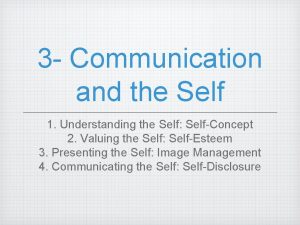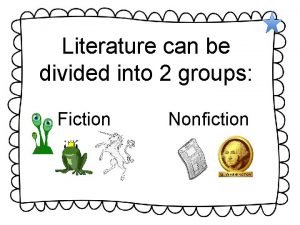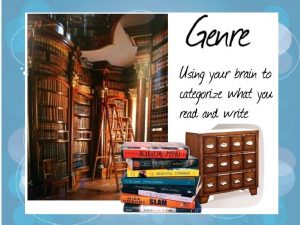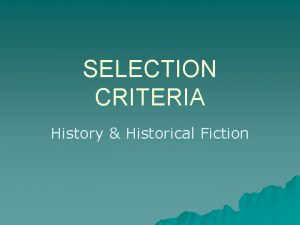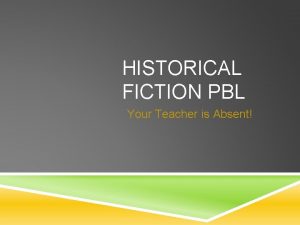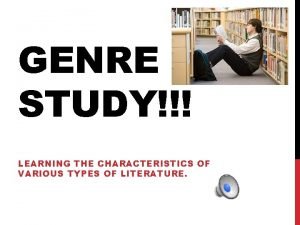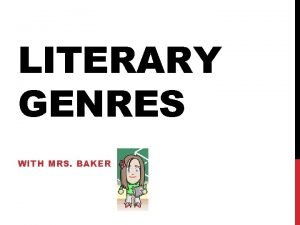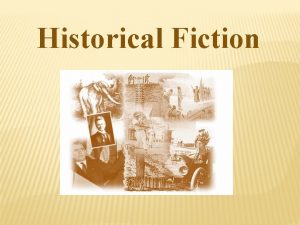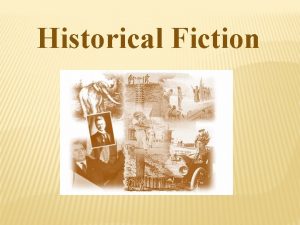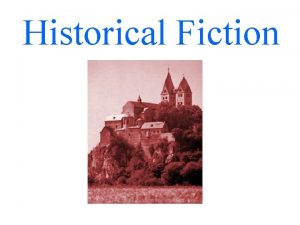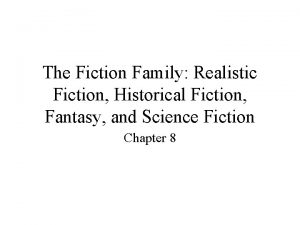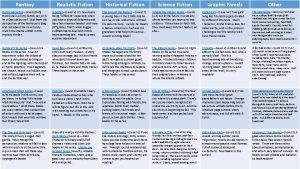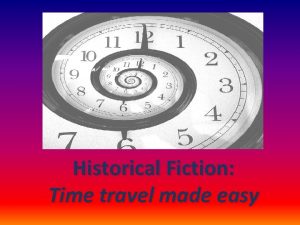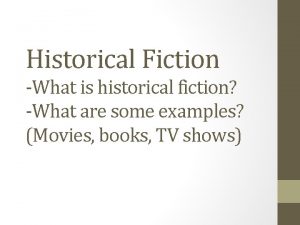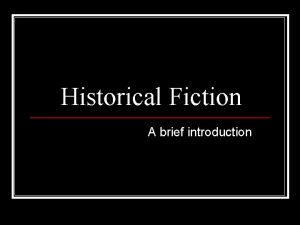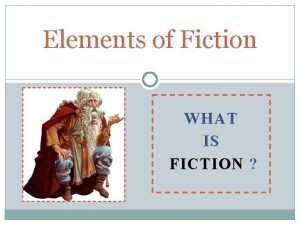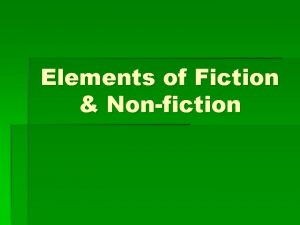Historical Fiction Historical Fiction Defined One way to


















- Slides: 18

Historical Fiction

Historical Fiction Defined One way to think about this genre is to think of Historical Fiction as the Realistic Fiction of the past. There are several different types of historical fiction. • The author can create a fictional story about an actual event or a real person. Dangerous Waters: an adventure on the Titanic by Gregory Mone or the classic Johnny Tremain are examples of this type. • The author might create a fictional character set in the context of a particular time and place as in the books Sarah Plain and Tall or Patrica Palacco’s Pink and Say. • An author might choose to focus on a social, political or economic concern. Many books have been written about the Triangle Shirtwaist Factory Fire and the conditions of women working in textile industry. Read Emily Arnold Mc. Cully’s picture book The Bobbin Girl for an example of this. • The author might relate a story loosely based on personal experience or memory. Little House in the Big Woods is an example of this.

Some subgenres of Historical Fiction Historical Fantasy is one type. These are stories set in the past with a fantastic element. The Cheshire Cheese Cat: a Dickens of a Tale by Carmen Agra Deedy & Randall Wright and Splendors and Glooms by Laura Amy Schlitz are good examples of this form. Alternate History imagines ‘what would the world be like if something happened differently in history. The Case of the Missing Moonstone by Jordan Stratford and The Inventor’s Secret by Andrea Cremer are two new examples of this intriguing subgenre. Steampunk is a subgenre of speculative fiction, usually set in an anachronistic Victorian or quasi-Victorian alternate history setting. It could be described ‘What the past would look like if the future had happened sooner. ’ It sets the scene as historical fiction but quickly moves into the realm of science fiction, fantasy or horror. For a terrific introduction to this genre check out Steampunk!: an Anthology of Fantastically Rich and Strange Stories edited by Kelly Link and Gavin J. Grant

What are the two most important elements of Historical Fiction?

Character Analysis • • • Pay attention to the Character’s Ethics Decide whether the character’s choices are wise What is the character’s motivation? What is the effect of the character’s actions on others? Pay attention to repeatedly used words that describe the character Read between the lines Is the character well developed-does the character change over time? Consider the character in the context of the historical time period. Should you use modern judgments about the past? What does the author think? What judgments has the author made about the characters that he or she has created.

Brainstorm: Physical characteristics of the characters Their thoughts, motives, actions. . . Their relationships to others Their feelings The Problems they face Next create a visual representation of a character from your novel

Accuracy Context Perspective(s) presented

Accuracy

Perspective

Perspective

Book Trailer

Context Think about the character of Columbus in terms of the context and how the he is depicted in that context

Doubly Historical • The author's perspective is shaped by the era in which he lived. • The author only has access to the historical research completed before the time the book is published. This shades the way characters and plot are imagined, even if the author’s research was thorough and the author's aim was to present "historical truth. " Sara L. Schwebel, author of Child-Sized History: Fictions of the Past in U. S. Classrooms.

Create a Classroom Museum to Establish Context

Think of at least three significant artifacts from the time period/setting • Why are these items significant to this character • Are these items particular to this time period

Primary source materials • a map • Photographs • Posters • Newspaper articles from the time Student Created Materials • a model airplane • a fictional letter • Imagined diary entries • A diorama

Integrating History with Literature

Week Seven Traditional Literature 3/24 Bring 3 variants of a folktale, myth, epic or legend 3/26 Binders are due adding 2 picture book responses related to your genre project. When you write your genre response consider the guides for evaluating that genre found in the resources that you use for the Genre project. The binder should now have 10 picture book and 4 novel responses, the picture book worksheet and journal entries for your reader autobiography. Plan for your Professional Development Events The Children’s Literature Festival is April 9 -14 th
 Contemporary realism literature
Contemporary realism literature Relative frequency two way table
Relative frequency two way table Two way anova
Two way anova Threaded avl tree
Threaded avl tree Perbedaan anova one way and two way
Perbedaan anova one way and two way 2 way anova example
2 way anova example One way anova vs two way anova
One way anova vs two way anova Analiza anova
Analiza anova Well defined set
Well defined set The way one wishes to be perceived by others is one's .
The way one wishes to be perceived by others is one's . It is genre of speculative fiction
It is genre of speculative fiction Characteristics of nonfiction
Characteristics of nonfiction Historical story
Historical story What is genre
What is genre Historical fiction defintion
Historical fiction defintion What are characteristics of historical fiction
What are characteristics of historical fiction Characteristics of historical fiction
Characteristics of historical fiction Questions about genres of literature
Questions about genres of literature One empire one god one emperor
One empire one god one emperor









